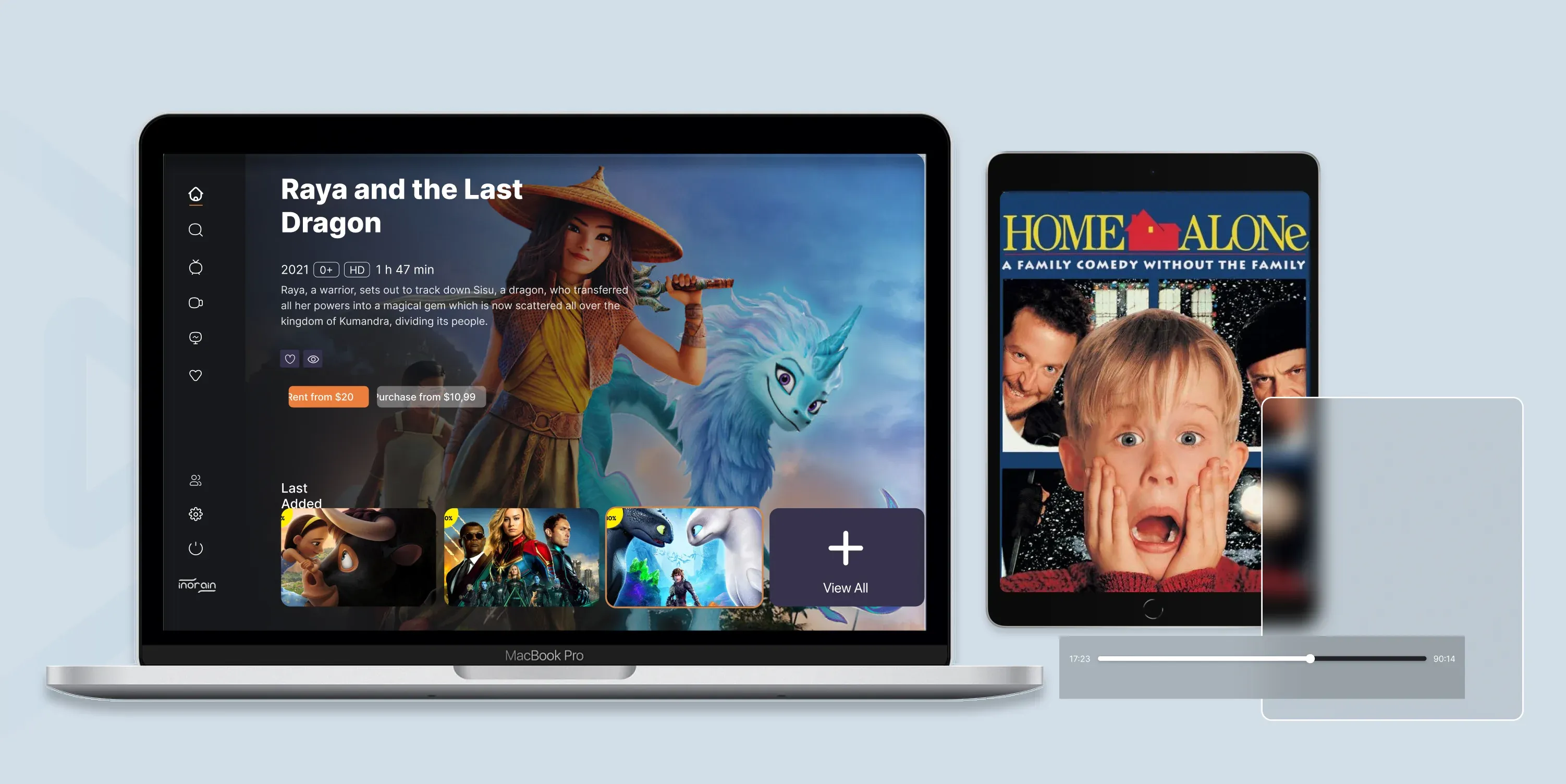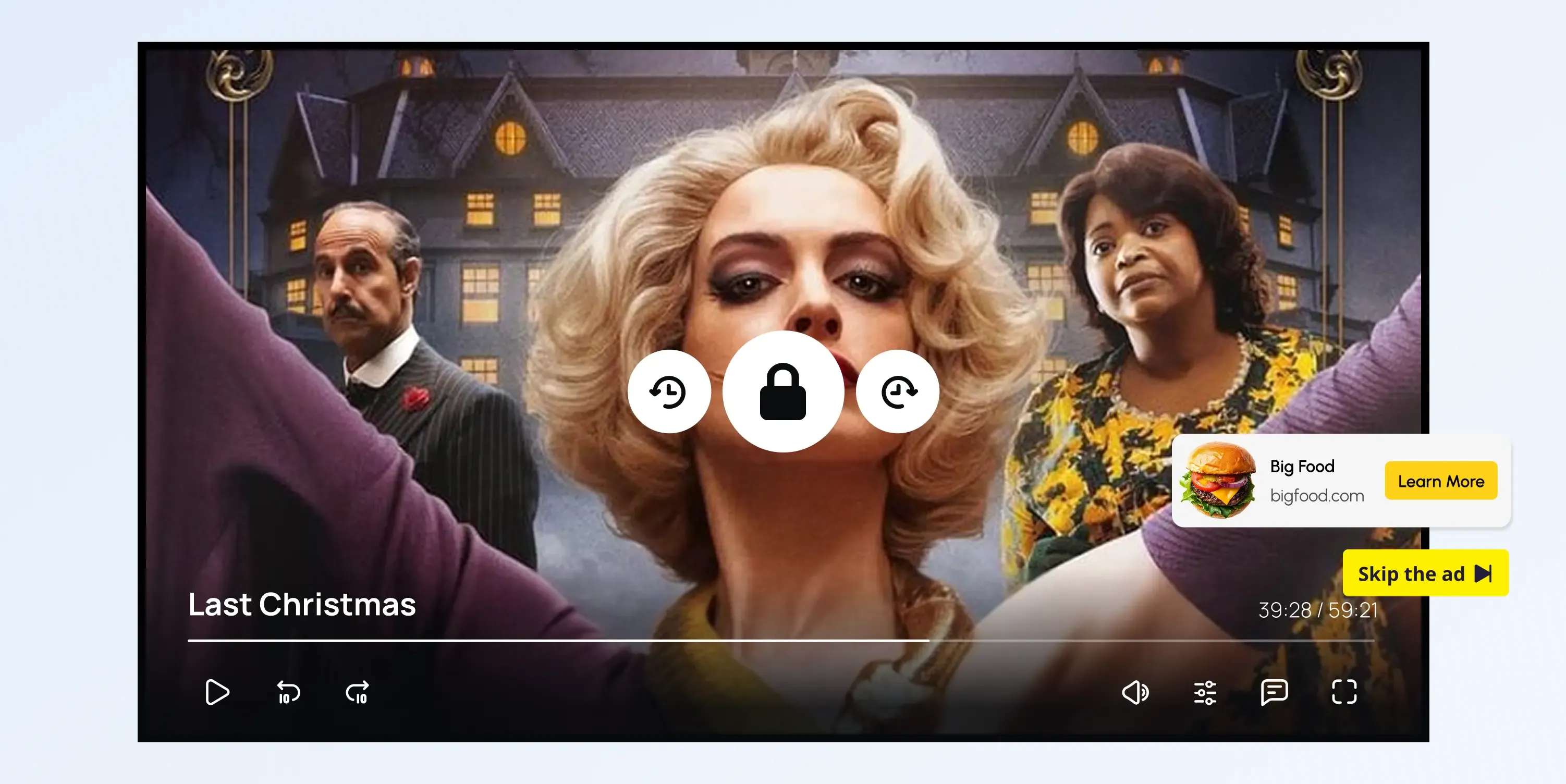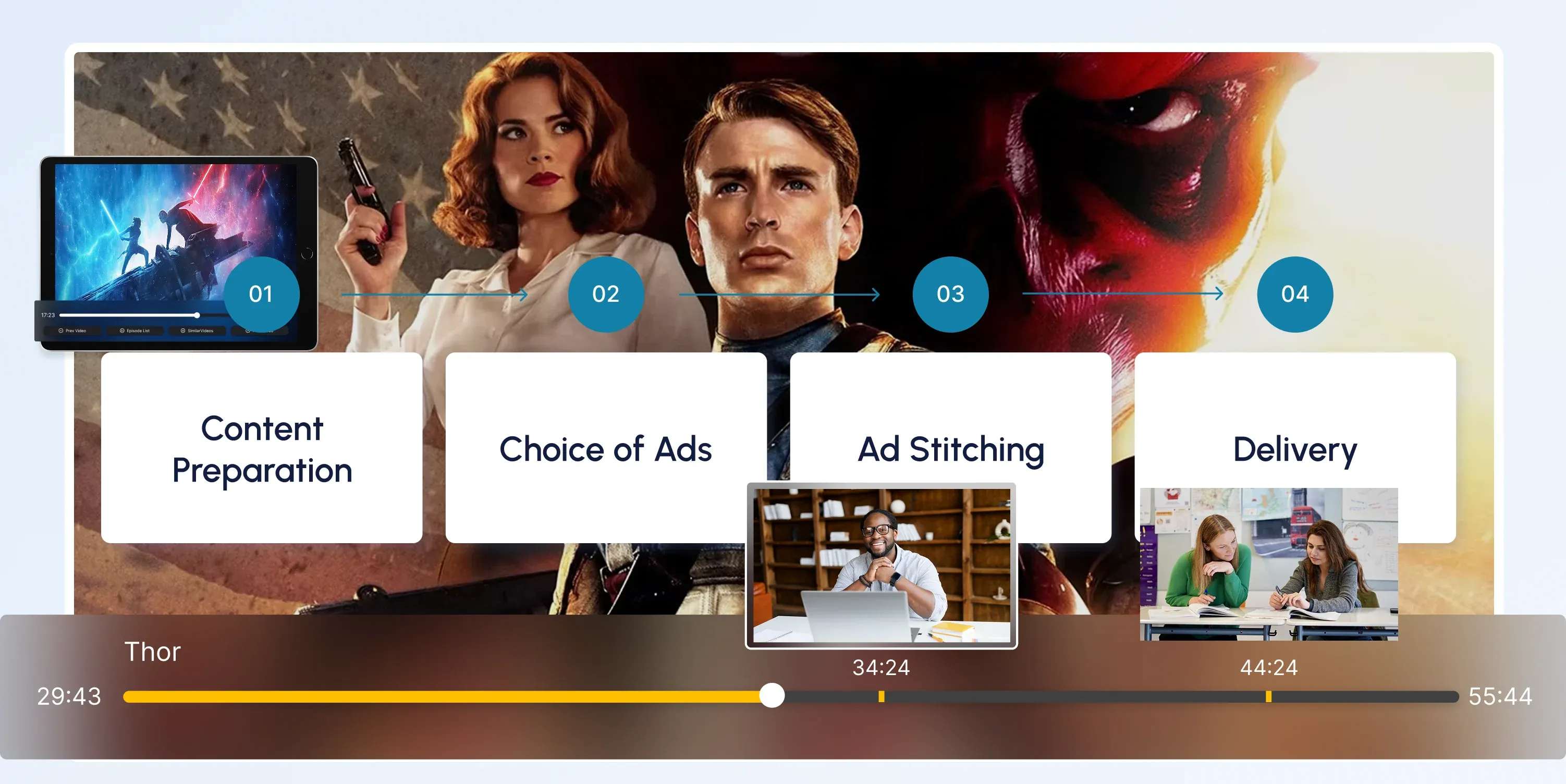Glossary term
Transcoding

What Is Transcoding?
Transcoding is the process of converting digital content from one compressed format, bitrate, or resolution to another, enabling optimized delivery and playback across various devices and networks.
The changes made by transcoding your video content can upscale or downscale it.
Note: Transcoding doesn’t necessarily improve the quality of your video content, but it can decrease it, depending on the codec you’re switching to.
Therefore, upscaling your video (e.g., SD to HD) does not mean improving its quality. However, you can lower video quality by changing its codec.
If it doesn’t improve video quality, then why do we need transcoding?
We don’t need transcoding to improve quality, but rather to make videos compatible with different devices, reduce file size, adjust resolution or bitrate, and enable smooth streaming across varying network conditions.
What Does Transcoding Change?
| Parameter | Example Change | Reason |
|---|---|---|
| Codec | H.264 → H.265 | Better compression and lower bandwidth usage |
| Bitrate | 10 Mbps → 3 Mbps | For slower networks or mobile delivery |
| Resolution | 1080p → 480p | For compatibility with older or smaller devices |
| Frame Rate | 60 fps → 30 fps | Lower processing needs on the client side |
| Container | MKV → MP4 | For platform compatibility (e.g., iOS prefers MP4) |
How Transcoding Works
Step 1: Prepare The Input Media
The transcoding process begins with a source file that has already been compressed and encoded, such as a .mov file using ProRes or H.264 (codecs). This file may be large and not optimized for streaming or efficient delivery. It serves as the starting point for all following operations.
Step 2: Decode The Media
Next, the transcoding engine decodes the input file into an uncompressed, raw format. This step removes the original compression to expose the raw video frames and audio data, providing full access for manipulation or conversion.
The decoding stage temporarily increases the file size, but it is necessary for making any changes to the media content.
Step 3: Process The Decoded Content
Once decoded, the system applies any required modifications. These may include transrating to reduce the bitrate, transizing to scale down the resolution, or adjusting the frame rate.
Additional processing can involve audio normalization, format changes, or metadata insertion such as watermarks, subtitles, or captions. This step ensures the final output matches the delivery requirements or device constraints.
Step 4: Re-encode into The Target Format
After making the necessary adjustments, the system re-encodes the processed content using the desired codec and container format.
For example, the transcoder might convert a 4K ProRes .mov file into a 720p H.264 .mp4 file suitable for online streaming.
This step compresses the content again, ideally with optimized settings for quality and efficiency.
Step 5: Output the final file or stream
Once re-encoding is complete, the system saves or packages the final media into the appropriate format for distribution. This could be a standalone file like .mp4 or a segmented format like HLS or MPEG-DASH for adaptive bitrate streaming.
If needed, the system can produce multiple renditions at various resolutions and bitrates to support different playback conditions.
Step 6: Deliver the media
Finally, the transcoded file is delivered to its destination. This involves uploading it to a content delivery network (CDN), making it available through a media player, or storing it in a video hosting system.
The end result is a format- and network-optimized media asset that is ready for distribution and playback across a wide range of devices and conditions.
Types of Transcoding
There are eight main types of transcoding. Each type serves a specific purpose in optimizing video or audio for delivery, compatibility, or performance.
1. Format Conversion (Codec Transcoding)
Changes the codec used to encode the media. Format conversion is used when the target device or platform does not support the original format.
Example: MPEG-2 → H.264 or H.264 → H.265
Purpose: Improve compression efficiency, reduce file size, or ensure playback compatibility.
2. Transrating (Bitrate Transcoding)
Transrating is the process of changing only the bitrate of a media file while keeping the same codec and resolution.
Used to match the bandwidth requirements of the target network or device.
Example: 15 Mbps → 3 Mbps
Purpose: Optimize for streaming performance, reduce buffering, and support adaptive bitrate streaming.
3. Transizing (Resolution Scaling)
Changes the spatial resolution (video dimensions) of the media (such as scaling down from HD to SD).
Often combined with format or bitrate adjustments.
Example: 4K (3840×2160) → 720p (1280×720)
Purpose: Enable playback on lower-resolution screens, reduce bandwidth, or improve performance.
4. Frame Rate Conversion
Frame rate conversion is the process of changing the number of frames per second (fps) in a video to match the requirements of a target platform, device, or broadcast standard.
Example: 60 fps → 30 fps
Purpose: Reduce processing load on devices, improve compatibility, or achieve cinematic effects.
5. Audio Transcoding
Audio transcoding is the process of decoding an audio file from one compressed format and re-encoding it into another format, bitrate, or sample rate.
Example: AAC 320 kbps → MP3 128 kbps, stereo → mono
Purpose: Reduce file size, ensure compatibility, or meet streaming platform requirements.
6. Container Transcoding (Transmuxing or Repackaging)
Transmuxing is the process of changing the container format of a media file without modifying the underlying video or audio codecs.
Example: TS → MP4, MP4 → MKV
Purpose: Adapt to platform compatibility (e.g., browsers, mobile apps) or streaming protocols (e.g., HLS, DASH).
7. Lossy Transcoding
Lossy transcoding is the process of recompressing media by permanently removing some data to make the file smaller and more efficient for delivery (can sacrifice a small amount of quality).
Use case: Streaming, mobile playback, low-bandwidth delivery
Purpose: Optimize for speed, size, and playback performance
8. Lossless Transcoding
Lossless transcoding is the process of re-encoding a media file without removing any data or quality. Unlike lossy transcoding, it preserves 100% of the original quality, even after compression, making it ideal for editing, archiving, or quality-sensitive workflows.
Use case: Archiving, editing, or maintaining master copies
Purpose: Preserve 100% of original content during format conversion or editing workflows.
What Affects Transcoding Performance?
Factor 1: Hardware (CPU/GPU)
CPU-based transcoding is flexible but slower, especially with large files or high-resolution content (e.g., 4K). GPU-accelerated transcoding (e.g., NVIDIA NVENC, Intel Quick Sync, AMD VCE) offloads encoding and/or decoding to specialized video hardware, speeding up performance significantly.
When to use GPU: Use GPU-based transcoding for real-time or live streaming, high-volume batch processing, or when running on power-efficient edge or embedded systems where speed and efficiency are critical.
When to use CPU: Use CPU-based transcoding when you need maximum codec compatibility, fine-grained control over encoding settings, higher quality for complex video formats, or when your hardware lacks dedicated GPU support.
It is ideal for offline media preparation, professional editing workflows, or environments that prioritize flexibility over speed.
Factor 2: Concurrency
Concurrency refers to how many simultaneous transcoding jobs a system can handle.
More jobs = more CPU/GPU/memory demand.
Impact: High concurrency without load balancing can cause dropped frames, slowdown, or system crashes.
Solutions like queueing, microservices, or autoscaling (in the cloud) help balance workloads.
Example Scenario: A VOD service that uploads 500 new videos per hour should process them in parallel using distributed workers or cloud-based encoders (e.g., AWS MediaConvert); otherwise, it will face severe processing delays and loss of adaptive bitrate support.
Factor 3: Latency
Latency is the delay between input and output during transcoding. It's critical for live streaming, where even 1–2 seconds can impact viewer experience.
Low-latency transcoding is required for:
- Live events
- Video conferencing
- Interactive streaming
The best ways to reduce latency are to use hardware-accelerated live encoders, minimize buffering and chunk sizes (e.g., with CMAF, LL-HLS), and skip unnecessary pre-processing or multi-pass encoding for live feed.
Factor 4: Storage I/O
Storage I/O (Input/Output) refers to the speed and efficiency with which data is read from or written to storage devices such as HDDs, SSDs, or cloud storage volumes.
Transcoding involves reading large input files and writing processed outputs, which means storage throughput and latency are crucial.
Poor disk I/O =
- Slower read and write = slower transcoding
- Bottlenecks during batch jobs or multi-bitrate processing
Solutions:
- Use **NVMe SSDs** or **RAID arrays**
- Separate **input and output disks** to avoid contention
- Optimize **chunked file handling** for large videos
Example: Transcoding a 4K video from HDD might take 30–40% longer than from SSD due to slow read speeds.
Transcoding vs Encoding
These two processes are mostly mistaken for the same thing, but it’s not true. These are two different steps that follow one another in video delivery. So, one can’t work without the other.
Let’s start with encoding.
Encoding is the process of taking raw, uncompressed media—such as video footage or audio recordings—and compressing it into a digital format using a codec (like H.264 or AAC) for storage, playback, or streaming.
It typically happens at the beginning of a content workflow when capturing or exporting media.
Once raw digital content is compressed or encoded, it’s finally time for transcoding.
So, transcoding takes media that has already been encoded and converts it into a different format, resolution, bitrate, or container to optimize it for a specific use case or platform.
This process includes tasks such as reducing the file size, making it compatible with various devices, and enabling adaptive bitrate streaming.
Remember: While encoding creates the initial compressed media, transcoding repurposes existing compressed media for broader distribution and compatibility.
Top 5 Use Cases for Video Transcoding
| Use Case | Description |
|---|---|
| Adaptive Bitrate Streaming | Transcodes a single video into multiple resolutions and bitrates for smooth playback on any network. |
| Device Compatibility | Converts videos into formats supported by various devices (smartphones, tablets, smart TVs, etc.). |
| Bandwidth Optimization | Reduces bitrate and file size to improve performance on mobile or low-bandwidth connections. |
| Live Streaming | Transcodes live input into multiple real-time outputs with varying quality levels. |
| Cloud Video Delivery | Prepares videos in streaming protocols (HLS, MPEG-DASH) for CDN distribution. |
Frequently Asked Questions
Content Writer
Anush Sargsyan is a content writer specializing in B2B content about OTT streaming technologies and digital media innovation. She creates informative, engaging content on video delivery, OTT monetization, and modern media technologies. The goal is to help readers easily understand complex ideas. Her writing is the bridge between technical detail and practical insight, making advanced concepts accessible for both industry professionals and general audiences.
Related terms

AVOD (Advertising-Based Video on Demand)
Explore how AVOD works, its monetization model, and why it's popular for free streaming platforms. Read the full definition on inorain.com glossary.

CSAI (Client-Side Ad Insertion)
Learn how CSAI delivers ads through the video player, enabling targeting, tracking, and monetization.

